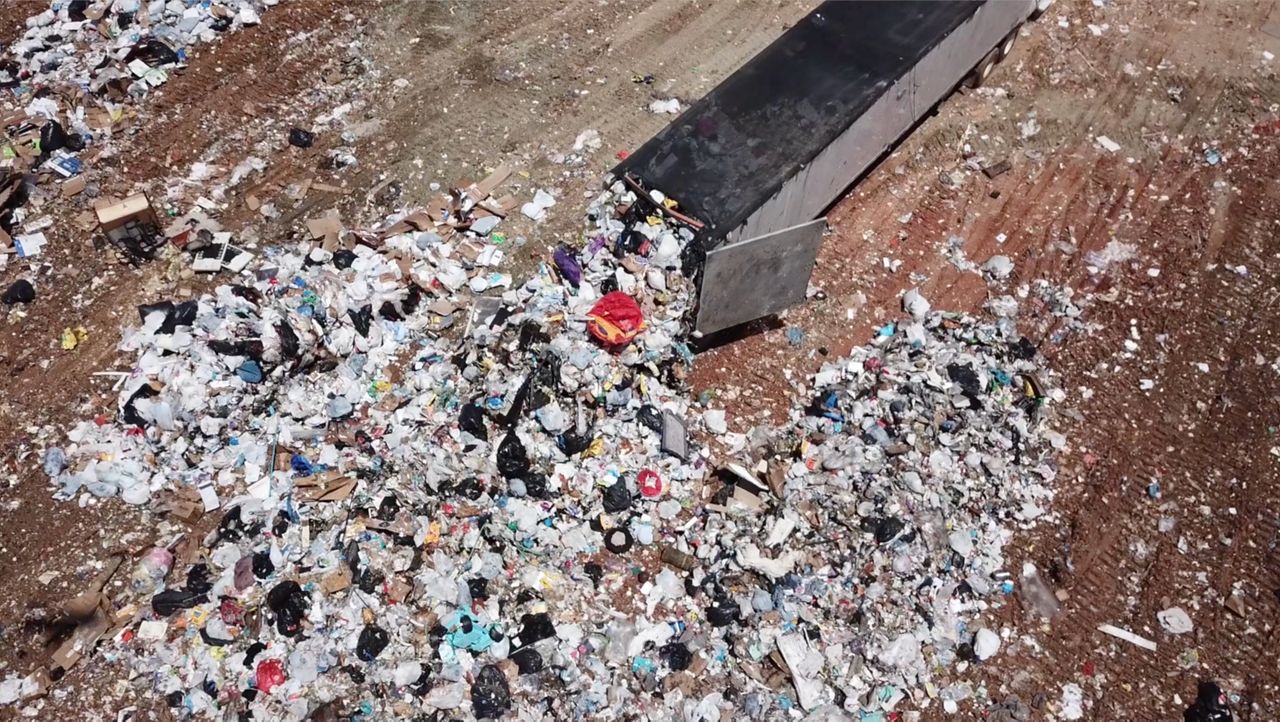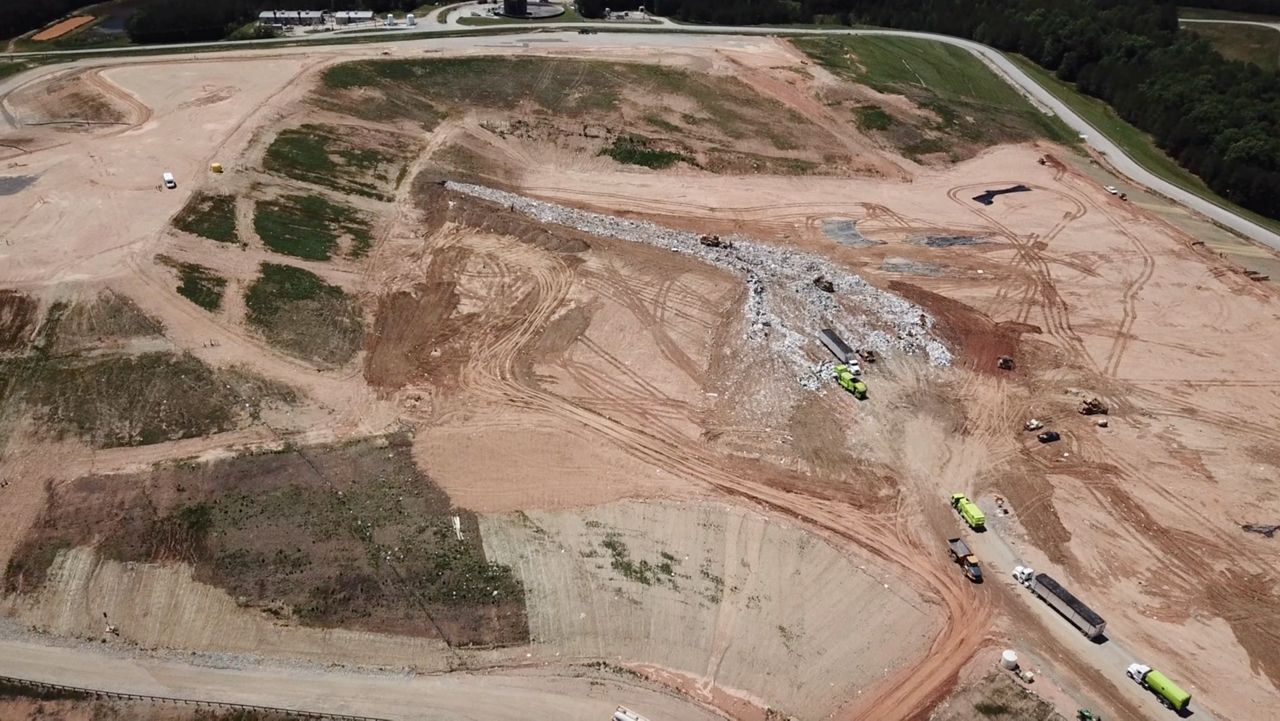WAKE COUNTY, N.C. — Wake County's landfill looks to be completely full by 2040, and there's no room to build another one within the county, leaving local officials searching for solutions. Meanwhile, landfill workers are aiming to reduce waste by educating people on how to decrease their trash amounts.
What You Need To Know
The Wake County Landfill will likely be full by 2040, and there’s no more room to build another landfill in the county
A large majority of the trash that goes to the landfill is either plastic or food waste
A 2020 plan suggests that once the landfill is full, the county will have to haul garbage outside the county
Wake County has been offering free tours of the landfill for about 15 years to educate people on trash disposal
“The first thing you will notice is the smell of garbage. We’re looking at about 1,500 tons that have just come in today,” Sara Davarbakhsh, the environmental education program coordinator for Wake County, said. “One thing I’ve noticed in this industry is it never stops. Every single day trash is coming in.”
The Wake County Landfill is a busy place. Tons of garbage is dropped off there each day, 365 days a year. Heaps of discarded everyday items are hauled in and shifted around.
“We receive anywhere from 155 to 175 garbage trucks per day,” Davarbakhsh said.
All of the garbage had to come from somewhere, and Davarbakhsh leads bus tours of the landfill in order to educate people about the impacts of landfills and trash.
“The truck comes on collection day, and they pick up that cart. It disappears. It’s empty and you fill it up again. You never think that there’s an impact,” Davarbakhsh said.
The tours are free and open to the public, because regardless of someone’s age or background, if they live in Wake County or just happen to visit, they are contributing to the landfill in one way or another.
“We want to show people the effects that their trash has on the environment, and all the complicated engineering features that are required to manage the amount of pollution that comes from landfills. How much time and resources and expense that it costs to build these landfills when if we could reduce our waste then the problem wouldn't be as big,” Davarbakhsh said.
Talking trash
“Eventually we are going to run out of natural resources. We won't be able to just keep throwing things in the landfill,” Davarbakhsh said.
The garbage brought to the Wake County Landfill is generated by more than one million people. But what’s in all of the trash that comes to the landfill? According to Davarbakhsh, 18.8% is plastic, including a lot of single-use plastic, like cups and plastic bags, while 24.8% is food waste.
Davarbakhsh says 72.3% of the garbage that comes to the landfill never even needed to be there in the first place.
“It could be repurposed. It could be recycled. It could be composted. It could be turned into a useful product that could stay in our circular economy and not be lost in a landfill, ” Davarbakhsh said.
Davarbakhsh says about 700 people take the Wake County Landfill tour every year, and she teaches them about the not-so-obvious environmental impacts of trash.
What's next once the space fills?
Once a section of a landfill is full, it’s sandwiched between thick layers of clay and liners. As the trash decomposes, it produces harmful gases that are trapped and vacuumed up using pipes. The gas is then burned and even used to produce electricity.
“We estimate that once the landfill is complete, we will be generating enough landfill gas, so we could power a town the size of Holly Springs from the landfill, ” Davarbakhsh said.
The garbage also creates a liquid known as leachate, which is essentially a cocktail that forms when waste breaks down and water, like rain, filters through that waste. Leachate has to be pre-treated before it’s piped to the wastewater treatment plant, but Davarbakhsh says a lot of this could be prevented if there was less garbage in the first place.
“We could have reduced the amount of landfill gas and pollution generated at the landfill if those items hadn't come here, ” Davarbakhsh said.

The Wake County Landfill was built in 2008, and it’ll be full by 2040, if not sooner. It’s very possible that we could run out of room to put garbage. Then what happens?
“We are going to have to look at alternate technologies to manage and dispose of that waste, things like composting, anaerobic digestion or even energy from waste where they incinerate the garbage, and they use the heat that comes from burning the waste to produce electricity,” Davarbakhsh said.
While the next step isn’t certain, Davarbakhsh says she’ll continue to do these tours with the hope that it makes people think differently about garbage.
“Seeing that ah-ha moment in people’s faces where they are like, ‘oh my gosh, this is not good, and I can do better than this,’” Davarbakhsh said.
Spectrum News 1 reached out to county officials for this report, and we were referred to the 2020 Comprehensive Solid Waste Management Plan, which looks at possibly hauling trash outside the county for disposal.
According to the plan, right now, no other sites have been found suitable for a landfill in Wake County, so waste will likely be hauled to a landfill outside of the county once the current one is full unless another method is chosen.
For more information on the Wake County Landfill tours, visit the county’s website.




